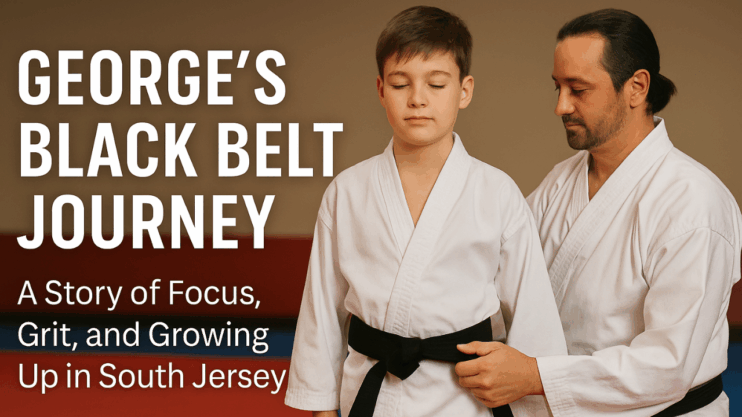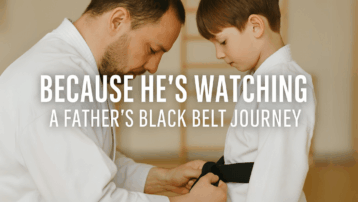George’s Black Belt Journey
A Story of Focus, Grit, and Growing Up
Why I’m Sharing This Story
Over the past 25+ years, I’ve taught thousands of students and worked with families from all walks of life. Many came to martial arts because their child needed something more—structure, discipline, a spark of belief. Some stuck with it. Some didn’t.
This story is about one of those students.
George is a fictional character, but his journey is made up of the very real stories I’ve witnessed in my dojo—especially here in South Jersey. The challenges he faces, the growth he experiences, and the transformation he achieves are all reflections of the truth I’ve lived alongside students and families for decades.
This story is for every child who’s been labeled, every parent who’s questioned if they’re doing enough, and every teacher or coach who dares to believe in what’s possible.
Let’s begin.
It Begins With a Belt…
The room was quiet. Knees on the mat. Eyes forward. A dozen students sat in seiza, breathing slow. Families watched from the back of the dojo, phones in hand and hearts in their throats.
George stood in front of his instructor—sweat still fresh from his black belt test. His gi was untucked. His eyes? Calm. Focused. Ready.
His instructor held out a neatly folded black belt with George’s name embroidered in gold.
With care and ceremony, the belt was tied around his waist. Not too tight. Not too loose. Just right.
“George,” the instructor said, “this isn’t the end. It’s the beginning of a new chapter.”
The applause came. But George wasn’t finished.
He stepped forward, unfolded a page from his gi pocket, and began to read.
George’s Black Belt Essay
“What Becoming a Black Belt Means To Me”
Age: 12
A black belt is not just something you wear. It’s something you earn—with sweat, tears, and a lot of second chances. To me, a black belt means I didn’t give up, even when I wanted to. It means I learned to control my temper, to focus when it was hard, and to respect myself and others. It means I can now help others the way my teachers helped me. Most of all, it means I found the strength inside me—and I learned how to use it.
—George
The Journey Behind the Belt
Age 5 – The First Class
George was five when his mom, Tanya, brought him to the dojo. A single mom working two jobs, she had just received another call from school:
“He had another meltdown.”
“He’s disruptive.”
“He can’t focus.”
Someone at work had told her, “Try karate. It helped my son.”
That first class? Chaos.
George cried. Refused to bow. Ran off the mat. But something in the space—the structure, the rhythm, the calm—stirred something in him.
His instructor knelt beside him and said:
“You already have strength. We’ll teach you how to use it.”
That was the beginning.
Ages 6–7 – Progress and Pain
Progress came slowly, and not without setbacks.
At school, George still struggled with reading. At home, he had outbursts and slammed doors. But at the dojo, he showed up. Belt by belt, stripe by stripe.
He helped younger students. He lined up his shoes. He shouted his creed.
But when asked to lead the school pledge in class one day, he froze. Forgot the words. Ran out crying.
That night, his sensei said:
“Next time you fall down, look for the lesson before you get up. That’s what black belts do.”
That became George’s mantra.
Age 8 – The Breaking Point
This was the hardest year.
George was bullied on the bus. One day, he snapped and punched a kid. He was suspended. The school suggested a behavioral program.
Tanya broke down in her car. Then she brought George back to the dojo.
There was no punishment—just a challenge:
“Write down why you want to stay on this path.”
George wrote:
“Because I want to stop being the kid who always loses control.”
He apologized. Did extra training. Re-earned trust.
That winter, he broke his first real board. It wasn’t just wood. It was fear. Shame. Doubt.
And it shattered.
Ages 9–11 – Rise and Responsibility
George began to rise—not just in rank, but in character.
He mentored beginners. Helped his little cousin with homework. Took on chores at home while Tanya managed health issues.
At school, he still faced challenges—but now he breathed, paused, journaled, asked for help.
In tournaments, he didn’t always win. But he always bowed. Always learned.
His instructors began to say,
“That’s black belt behavior.”
Age 12 – The Test and the Transformation
Two hours. Katas. Sparring. Reflection. Character questions.
George showed up early. Focused. Grounded. Ready.
And when it was over, he stood tall—with his black belt tied around his waist, his journey etched into every knot and fold.
Back to the Present
George folded his essay and returned to kneeling. His mom watched from the back, tears in her eyes.
He looked down at the belt.
It was black. But it held the weight of everything he’d been through—his struggle, his growth, his choice not to quit.
Closing Reflection
George’s story is one of many.
He represents every child who’s been told they’re too much… or not enough.
Every parent who’s wondered if they’re doing the right thing.
Every teacher or coach who dares to believe in transformation.
A black belt doesn’t make someone perfect.
It simply marks the moment they’ve proven—to themselves—that they can overcome.
This is why we train.
Why we teach.
Why we Live Strong.
—Master Peter Liciaga




